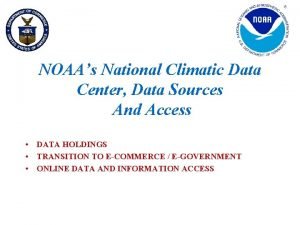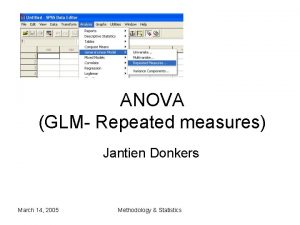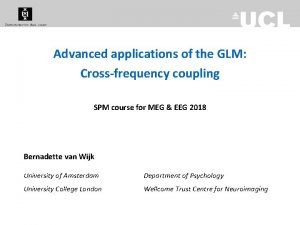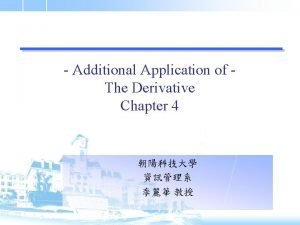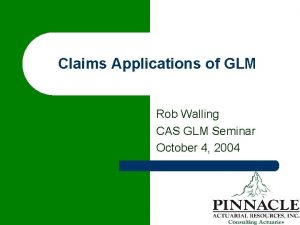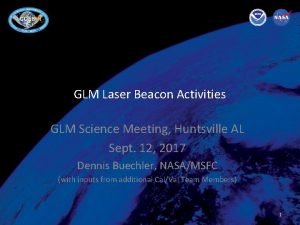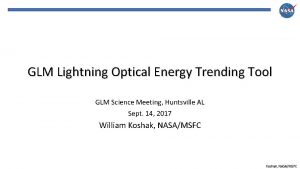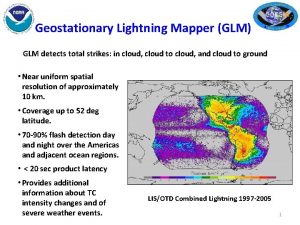First Applications of GLM Data for National Climate












- Slides: 12

First Applications of GLM Data for National Climate Assessment (NCA) Studies William Koshak 1, Kenneth Cummins 2, Brian Vant-Hull 3, Themis Chronis 4 1 NASA Marshall Space Flight Center (MSFC), Huntsville, AL 2 University of Arizona (UA), Tucson, AZ 3 City College of New York (CCNY), New York, NY 4 University of Alabama in Huntsville (UAH), Huntsville, AL American Geophysical Union (AGU) Meeting, 10 December 2018

National Climate Assessment (NCA) Program ü Congressionally Mandated: Global Change Research Act (1990) ü Vision: To advance an inclusive, broad based, and sustained process for assessing and communicating scientific knowledge of the impacts, risks, and vulnerabilities associated with a changing global climate in support of decision-making across the US. ü USGCRP Oversees the NCA Process o 13 Federal Depts/Agencies Involved ü Culminates in regular NCA Assessment Reports o o NCA 1 completed in 2000 NCA 2 completed in 2009 NCA 3 completed in 2014 NCA 4 completed in 2018 WMO recently added lightning to the Global Climate Observing System (GCOS) list of Essential Climate Variables (ECVs) Koshak, NASA/MSFC

Lightning/Climate Interaction higher albedo (cooling) Increased Convection Multiple Effects Warming Climate Impacts: Lightning Increase Over Land 17%/ o. C (dry bulb) 40%/ o. C (wet bulb) 56% /o. C (wet, N. Hem) Increased Lightning death/injury wildfires power outages crop damage property damage delays (airport, launch). . . Other Drivers Increased O 3 and other GG Increased LNOx Koshak, NASA/MSFC

10 mo Trend (Jan-Oct, 2018) CONUS Flash Density GLM-16 NLDN NW Not Corrected Koshak, NASA/MSFC

NLDN 10 months (Jan-Oct, 2018) GLM-16 NW Not Corrected Koshak, NASA/MSFC

Two Optical Energy Metrics Sensor-Intercepted Energy Total Upward Energy (from cloud-top surface) sum upward flux from each event isotropy assumed Koshak, NASA/MSFC

Flash Optical Energy Q (Broad View): 9. 5 mo (2018: Jan 1 – Oct 15); ~ 300 M flashes Size = 298, 386, 767 Mean = 254. 3 f. J Std. Dev. = 557. 7 f. J Max = 100, 004. 4 f. J Median = 87. 0 f. J Min = 1. 5 f. J Flash Energy Freq. Dist. 400 300 200 Mean Daily Flash Energy TREND (f. J) 100 0 0 200 100 Time (days since start) 300 Koshak, NASA/MSFC

Long-Term Trend of TRMM/LIS Mean CONUS Upward Flash Optical Energy ℇ Trends down to 2011, then trends up. Oscillates!. . . with peak in Winter. Koshak, W. J, Lightning NOx estimates from space-based lightning imagers, 16 th Annual CMAS Conference, Chapel Hill, NC, October 23 -25, 2017 Koshak, NASA/MSFC

10 mo Trend (Jan-Oct, 2018) of GLM-16 CONUS Incident Flash Optical Energy Q Monthly Variation NW Not Corrected Mean Q per flash in grid cell Total Q from all flashes in grid cell Koshak, NASA/MSFC

Koshak, NASA/MSFC

10 mo Trend (Jan-Oct, 2018) of GLM-16 CONUS LNOx Production P Estimate Monthly Variation NW Not Corrected Mean P per flash in grid cell Total P from all flashes in grid cell Koshak, NASA/MSFC

Summary • GLM is a new effective tool for probing lightning/climate relations for NCA program, and for improving air quality modeling. • Major benefits: 24/7 continuous monitoring, & total lightning detection. • Allows for continuous monitoring of Z ratio when GLM combined with NLDN data. • GLM trending of flash optical energy, Q, has begun which is a proxy to flash LNOx production (and which directly affects greenhouse gas concentrations, such as ozone). Koshak, NASA/MSFC
 Nndc climate data online
Nndc climate data online Climate change 2014 mitigation of climate change
Climate change 2014 mitigation of climate change Time0
Time0 Glm multiply vector by scalar
Glm multiply vector by scalar Glm repeated measures spss
Glm repeated measures spss Glm nedir
Glm nedir Glm
Glm Glm cross
Glm cross Climate change national security threat
Climate change national security threat Applications of the first derivative
Applications of the first derivative Iso 22301 utbildning
Iso 22301 utbildning Novell typiska drag
Novell typiska drag Nationell inriktning för artificiell intelligens
Nationell inriktning för artificiell intelligens
